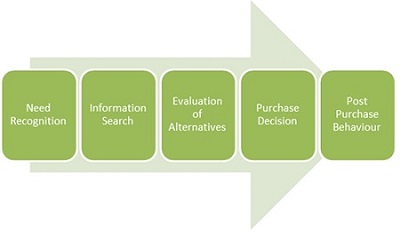
- Consumer Behavior - Home
- Consumer Behavior - Consumerism
- Consumer Behavior - Significance
- Demand Analysis
- Buying Decision Process
- Developing Marketing Concepts
- Marketing Strategies
- Market Segmentation
- Market Positioning
- Individual Determinants
- Consumer Behavior - Motivation
- Personality & Self Concept
- Attention & Perception
- Consumer Behavior - Learning
- Consumer Behavior - Attitude
- External Influence
- Influence of Culture & Social Class
- Relationship Marketing
- Reference Group
- Models of Consumer Behavior
- Consumer Behavior - Models Types
- Implications of Marketing Models
- Online Customer Behavior
- Consumer Behavior - Expectations
- Emerging Trends
- Emerging Issues
- Consumer Behavior - Cross Culture
- Consumer Behavior Resources
- Consumer Behavior - Quick Guide
- Consumer Behavior - Resources
- Consumer Behavior - Discussion
Consumer Behavior - Decision Making
An understanding of consumer behavior is necessary for the long-term success and survival of a firm. Consumer decision making is viewed as the edifice of the marketing concept, an important orientation in marketing management.

The marketer should be able to determine needs and wants of the target segment and provide product and service offerings more effectively and efficiently than competitors.
Types of Consumer Decision Making
The following are the types of decision making methods which can be used to analyze consumer behavior −
Extensive Problem Solving
In extensive decision making, the consumers have no established or set criteria for evaluating a product in a particular category. Here the consumers have not narrowed the number of brands from which they would like to consider and so their decision making efforts can be classified as extensive problem solving. In this particular set of problem solving phase, the consumer needs a lot of information to set a criteria on the basis of specific brands could be judged.
Limited Problem Solving
In limited problem solving, the consumers have already set the basic criteria or standard for evaluating the products. However, they have not fully set the established preferences and they search for additional information to discriminate among other products or brands.
Routinized Response Behavior
Here, in routinized response behavior, consumers have experience with the product and they have set the criteria for which they tend to evaluate the brands they are considering. In some situations, they may want to collect a small amount of additional information, while in others they may simply review what they are aware about. In extensive problem solving, consumer seeks for more information to make a choice, in limited problem solving consumers have the basic idea or the criteria set for evaluation, whereas in routinized response behavior consumers need only little additional information.
Views of Consumer Decision Making
An Economic View
Consumers have generally been assumed to make rational decisions. The economic view of consumer decision making is being criticized by researchers because a consumer is assumed to posses the following traits to behave rationally −
Firstly, they need to be aware of all the alternatives present in the market
Secondly, they must be able to efficiently rank the products as per their benefits.
Lastly, they must also know the best alternative that suits them as per their requirements.
In the world of perfect competition, consumers rarely have all the information to make the so called perfect decision.
A Passive View
Passive view is totally opposite to the economic view. Here, it is assumed that consumers are impulsive and irrational while making a purchase. The main limitation of this view is that consumers also seek information about the alternatives available and make rational or wise decisions and purchase the products or services that provides the greatest satisfaction.
A Cognitive View
The cognitive model helps individuals to focus on the processes through which they can get information about selected brands. In the framework of cognitive view, the consumer very actively searches for such products or services that can fulfill all their requirements.
An Emotional View
Consumers are associated with deep feelings or emotions such as, fear, love, hope etc. These emotions are likely to be highly involving.